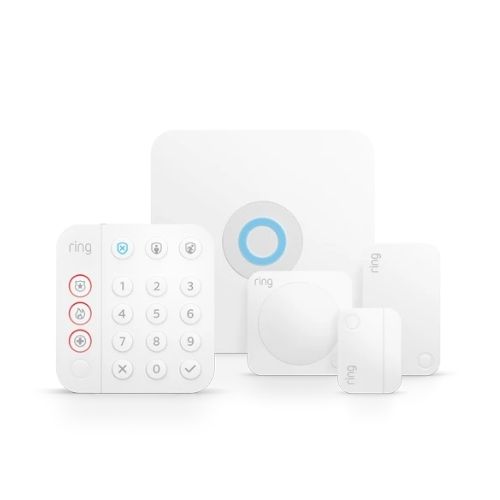Unsurprisingly, Nest garners overwhelmingly positive reviews on its website, but a deeper dive into the company’s reputation turns up customer service concerns with long wait times and delayed camera connectivity.1,2
While there is the safety net of a 30-day money-back guarantee and a two-year warranty, service complaints are an issue for Nest.
The company’s user-friendly app lets you control Nest thermostats, smoke and carbon monoxide detectors, and several third-party devices like Philips Hue smart lighting. The Nest app also integrates and controls feeds from both outdoor and indoor Nest cameras as well as Nest Hello, the brand’s video doorbell camera.
You can arm Nest Secure using voice recognition through smart home hubs Amazon Echo and Google Home. The downside to this dynamic menu of compatible home automation features is that video storage and monitoring plans are more expensive.
Alarms, alerts, and notifications
Nest Secure is hampered by some vulnerabilities and limitations of the actual alarm system. Because the “brain” of the alarm exists in the same place as the keypad of the Nest Guard component, the system may be more easily disabled by intruders.
Customers also report sensors have a limited range of motion (about 10 feet) and the alarm is relatively quiet. Nest bills this as an advantage for customers who want a less intrusive home security system, but without the ability to add speakers (there’s just one located at the entry), Nest Secure may be too quiet for larger homes.
It all began with the wildly popular Ring video doorbell, but now the company also offers an attractive, easy-to-install security system at a significant bargain. While it does have some drawbacks, Ring Alarm is one of the most affordable DIY home security solutions available.
Ring Alarm puts DIY home security at your fingertips without a contract, but it does so by sacrificing some features and functionality. Currently, the limited smart home integration is Ring’s Achilles’ heel, and it makes the flexibility to build out a complete smart home difficult.
The Ring Alarm starter kit offers only one motion sensor and one contact sensor, but additional sensors and other add-on components are reasonably affordable.
Check out our Ring FAQ for more info on Ring.
Ring Alarm is the more affordable choice for both equipment and monitoring, but it might not be your best option for long-term concerns like home automation integration and alert customization.
With easy DIY installation and sleek components, it can give you the styling of Nest without the price tag.
The absence of a trial period and extended warranty on the lower-tier plan can also be a red flag, but Ring’s reputation for reliable customer service should put some of those fears to rest. Hopefully, as Amazon invests in building out the Ring suite of home security products, we’ll get the home automation features and flexibility that the company has brought to other smart home devices.
Read our full Ring home security review to learn more.
In the UK? Check out our Ring UK Review.
For more information, view our in-depth guide to Ring video storage plans.
| Ring Protect Basic
| Ring Protect Plus
|
|---|
| Price | $3/mo.$30/yr.
| $10/mo.$100/yr.
|
|---|
| Includes professional monitoring |
 No No |
 Yes Yes
|
|---|
| Contract | None
| None
|
|---|
| Features | 60-day video history
1-year warranty
One doorbell or camera
| 60-day video history
Extended warranty
Unlimited Ring devices
|
|---|
| Learn more | View packages | View packages |
|---|
Info current as of 07/09/2020. Offers and availability may vary by location and are subject to change.

Pros

No contract

Affordable starter kit

Good customer service

Inexpensive professional monitoring available

Easy DIY installation

Cons

Limited smart home integration

Small starter kit

Pre-programmed alert settings
Ring Alarm is a no-contract, no-frills system, but its bargain-basement price means you get only a one-year limited warranty and no trial period with the Protect Basic plan. For an extended warranty and a standard 30-day trial period, you’ll need a Protect Plus plan.
We don't recommend the Basic Plan if you use this system, since it has no professional monitoring option and benefits only a single Ring security camera.
Ring offers 24/7 live customer service, though the Ring Alarm product is relatively new, and the jury is still out about how specific concerns are being addressed. But most retail customers give a better-than-average rating of four out of five stars for Ring Alarm products, and the Better Business Bureau grades Ring as an A+.3
Ring hasn’t disclosed who it partners with for its optional 24/7 professional monitoring. The relatively low cost of the monitoring plan and Ring’s lack of transparency could make you hesitant to sign up.
Once you get the packaging open, Ring’s tool-free installation is a breeze. One drawback of the installation is that Ring’s alert settings come pre-programmed, and while they can be adjusted, it can be tricky to figure out how.
Customers report that while there’s lots of instruction surrounding Ring's doorbell cameras, there is a limited amount of information about Ring Alarm available online.
First, the good news. Ring Alarm has both Z-Wave and Zigbee connectivity, so it could integrate with a myriad of home automation devices in theory. Unfortunately, that capability isn’t fully functional, which means Ring Alarm is compatible with only some third-party devices, and the system is difficult to customize.
For instance, you’ll discover you can view Ring camera video in the app alongside your system status and alerts, but you can’t set up automatic recording for tripped sensors. While Ring Alarm can be armed and disarmed by Alexa, there isn’t much more integration in terms of smart home functionality.
One exception is that Ring Alarm’s system is compatible with First Alert smoke and carbon monoxide detectors and a limited number of Z-Wave electronic door locks.
Learn more in our Ring equipment and compatibility guide.
A word about wireless security
Several Ring Alarm and camera users have reported breaches in their accounts that allowed a stranger to use the two-way communication to intimidate them. This is a risk every user takes when they use any internet-connected wireless system.
The good news is you can minimize the risk with proper internet security. Here are a few easy tips for securing your system from online threats:
- Use strong, unique passwords for all your accounts
- Opt for extra security measures like two-factor authentication
- Add shared users instead of sharing login credentials
- Change your home Wi-Fi password frequently
We still confidently recommend Ring and other similar wireless internet-connected systems. And while these threats are real, they can be avoided with a few extra precautions.






